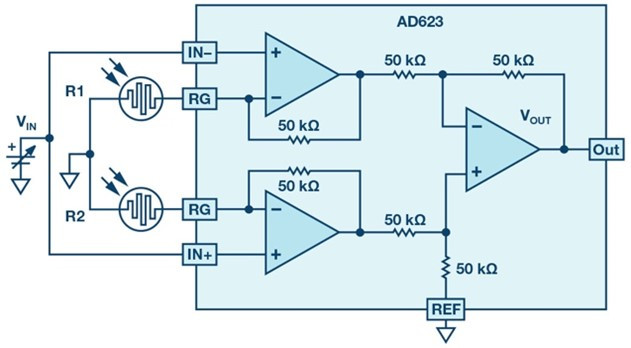Mastering Light Intensity: A Deep Dive into Advanced Measurement Techniques
19-10-2023 | By Jack Pollard
In the intricate world of lighting applications, the need to measure and compare the intensity of two distinct light sources is not just common but essential. Whether it’s about maintaining a consistent brightness level in control rooms or ensuring optimal light conditions in production environments, the ability to measure relative light intensity plays a pivotal role. But here arises a pertinent question - "Can the difference between two light sources be measured with an instrumentation amplifier?"
The answer lies in the innovative application of the AD623 instrumentation amplifier, a device known for its precision and versatility. By replacing the main setting resistor with two photoresistors, professionals can effectively measure the differential outputs of two additional light detectors, converting their difference into a single-ended voltage signal with a ground reference. This mechanism not only offers a precise measurement but also ensures that the two light sources shine with equivalent intensity, maintaining a harmonious balance in illumination.
This article delves into the technicalities of this process, unraveling the intricacies of the AD623 instrumentation amplifier’s application in measuring relative light densities. With real-world examples, visual aids, and technical insights, we aim to provide a comprehensive overview that caters to both novices and seasoned professionals in the field.
The Mechanism of Comparison
In the realm of lighting applications, the ability to accurately measure the relative intensity of two light sources is paramount. This necessity transcends the mere quantification of individual intensities, focusing instead on ensuring that both light sources emanate equivalent luminosity. This is particularly crucial in scenarios such as comparing the brightness within a control room to that of another room, ensuring consistent lighting conditions regardless of the time of day.
The schematic illustrated in employs the AD623 instrumentation amplifier in conjunction with two Light Dependent Resistors (LDRs) to effectively measure relative light densities. LDRs, or photoresistors, are passive electronic components characterized by variable resistance that fluctuates in accordance with light intensity. In the depicted circuit, LDR1 serves as the primary sensor, establishing a reference point for light intensity and facilitating comparisons either during the day or night.
When subjected to equal amounts of light, both LDRs exhibit identical resistances, resulting in a zero current difference and an output voltage of zero volts. However, disparities in room illumination yield differences in the intensities of the two light sources, generating a voltage at the system’s output. This voltage’s polarity is indicative of the room with superior brightness, offering real-time insights into the relative lighting conditions and enabling informed adjustments to achieve desired illumination levels.
Practical Applications and Results
The practicality of the AD623 instrumentation amplifier and LDRs extends beyond theoretical postulations, finding tangible applications in real-world scenarios. In the context of the circuit depicted in below, two LEDs at the output of the AD623 serve as intuitive indicators of relative light intensity. A positive output voltage, signifying superior illumination on LDR2, activates the red LED. Conversely, the yellow LED illuminates when light source 1 is brighter, offering an immediate visual representation of the prevailing lighting conditions.
A positive output voltage, signifying superior illumination on LDR2, activates the red LED. Conversely, the yellow LED illuminates when light source 1 is brighter, offering an immediate visual representation of the prevailing lighting conditions.
Figure 3 exemplifies the output voltage’s role as a reliable indicator of relative light intensity. In this instance, a 1Vp-p square wave at a frequency of 1kHz yields an output of approximately 2V, denoting that Room 2 is more brightly illuminated. This real-time feedback mechanism is instrumental in facilitating instantaneous adjustments to ensure consistent lighting across both rooms. The LEDs’ brightness levels serve as a nuanced representation of the amplitude level of the relative intensity of the rooms, offering granular insights into the prevailing lighting conditions.
The AD623 is not just a tool but a conduit for enhanced lighting precision. Its low power consumption, coupled with its ability to be powered by two AA batteries, underscores its applicability in power-sensitive scenarios. Whether it’s achieving optimal lighting conditions in control rooms or ensuring the consistent brightness of production environments, the AD623 stands as a testament to the amalgamation of precision, innovation, and practicality in lighting applications.
Conclusion
The integration of the AD623 instrumentation amplifier with light dependent resistors unveils a world of precision and efficiency in measuring the relative intensity of two light sources. This innovative approach transcends conventional methods, offering real-time, accurate, and visually intuitive insights into the comparative brightness of distinct light sources. In an era where lighting precision is not just a necessity but a mandate, the AD623 emerges as a pivotal tool in the arsenal of professionals and enthusiasts alike.
Every component, from the meticulously designed LDRs to the precision-engineered AD623, converges to create a system that is as reliable as it is efficient. The real-time feedback mechanism, exemplified by the intuitive LED indicators, ensures that users are always abreast of the prevailing lighting conditions, enabling instantaneous adjustments to achieve the desired illumination levels. In scenarios where consistency in lighting is paramount, the AD623’s precision and reliability stand uncontested.
As we venture further into an age characterized by technological innovation and precision, the AD623’s role in lighting applications is poised to become increasingly significant. Its low power consumption, precision, and real-time feedback mechanisms underscore its status as an indispensable tool in achieving optimal lighting conditions. In the intricate dance of shadows and light, the AD623 instrumentation amplifier emerges not just as a participant, but as a maestro, orchestrating an era of lighting precision that is as unprecedented as it is essential.
This article was written by Chau Tran, Analog Devices. He joined Analog Devices in 1984, where he works in the Instrumentation Amplifier Products (IAP) Group in Wilmington, MA. In 1990, he graduated with an M.S.E.E. degree from Tufts University. Tran holds more than 10 patents and has authored more than 10 technical articles.

